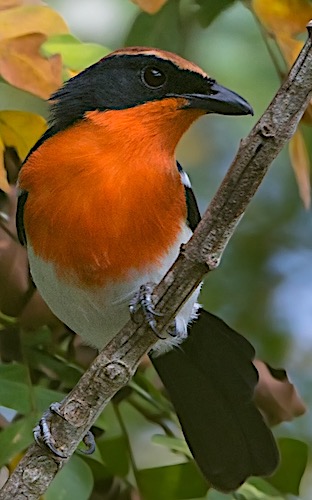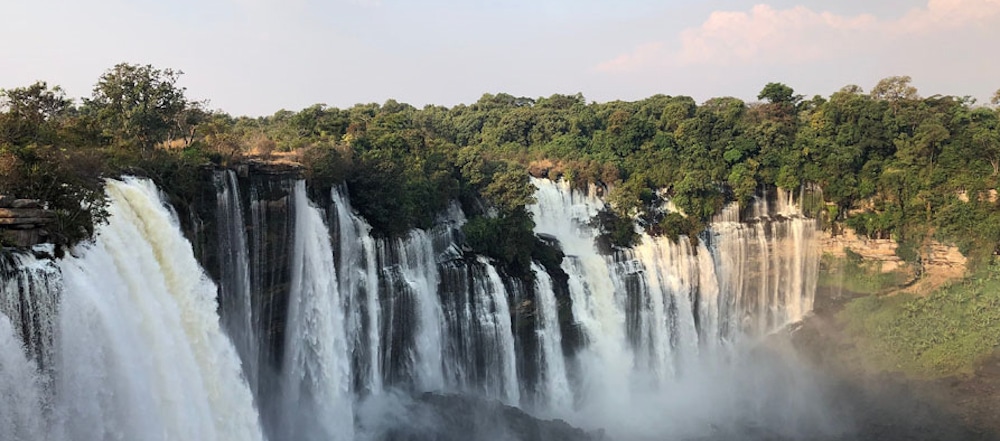Republic of Angola

Angola is the seventh largest country in Africa and the twenty-fourth in the world, covering c.1,250,000 Km² (c. 500,000 square miles). It is bordered by Namibia to the south, the Democratic Republic of the Congo to the north, Zambia to the east, and the Atlantic Ocean to the west. Angola has an exclave province, the province of Cabinda, that borders the Republic of the Congo and the Democratic Republic of the Congo. The capital and most populous city is the port of Luanda. Angola has approaching 38 million people of which nearly ten million live in or around the capital. Angola has a favourable coastline for maritime trade with four natural harbours: Luanda, Lobito, Moçâmedes, and Porto Alexandre. These natural indentations contrast with Africa’s typical coastline of rocky cliffs and deep bays.
Angola experiences distinct, alternating rainy and dry seasons. In the north, the rainy season may last for as long as seven months—usually from September to April, with perhaps a brief slackening in January or February. In the south, the rainy season begins later, in November, and lasts until about February.[59] The dry season (cacimbo) is often characterised by a heavy morning mist.
Angola has vast mineral and petroleum reserves, and its economy is among the fastest-growing in the world, especially since the end of the civil war; however, economic growth is highly uneven, with most of the nation’s wealth concentrated in a disproportionately small part of the population. Less than 3 per cent of Angola’s abundant fertile land is cultivated and the economic potential of the forestry sector remains largely unexploited partly due to extensive minefields laid during the country’s civil war.
Angola is rich in wildlife, home to 117 species of amphibians, 278 reptiles, 291 species of mammals and at least 940 species of birds.
Birding Angola
Angola is a diverse country, with lush rainforests in the north, cool mountains, huge waterfalls and arid desert in the southwest. The natural diversity is accompanied by a diversity of local cultures. An enthusiast birder can see well over 400 species in a birding trip of 3 weeks, of which 14 are endemic (depending on taxonomy), while dozens of other near-endemic and highly localised bird species also feature prominently. This is a testament for the many habitats within the country, including desert, dry thorn savanna, mopane, moist baobab savanna, montane forest and grassland, lowland rainforest, and vast areas of miombo broadleaf woodland.

Kalandula Falls ©Dylan Vasapolli
Other natural attractions include the bizarre Welwitschia plant, the endangered Giant Black Sable antelope, the breath-taking Calandula Waterfall, the spectacular Tundavala cliffs, and many other gems.
Most visitors will arrive via international flights into the capital of Luanda. There are direct flights from Lisbon, Paris, Amsterdam, Brussels, Frankfurt, Johannesburg, and Sao Paulo. Angola can also be reached overland via border crossings from Namibia.
-
Birding Angola
https://birdingangola.com
-
Number of bird species: 1008
(As at March 2024)
Number of endemics: 13-20
Grey-striped Francolin Francolinus griseostriatus
Swierstra's Francolin Francolinus swierstrai
Red-crested Turaco Tauraco erythrolophus
Red-backed Mousebird Colius castanotus
White-fronted Wattle-eye Platysteira albifrons
Angola Helmet-Shrike Prionops gabela
Braun’s Bush-Shrike Laniarius brauni
Gabela Bush-Shrike Laniarius amboimensis
Pulitzer's Longbill Macrosphenus pulitzeri
Angola Slaty Flycatcher Melaenornis brunneus
Gabela Akalat Sheppardia gabela
Angolan Waxbill Coccopygia bocagei
are agreed by all to be true endemics.Pale-throated Barbet Gymnobucco vernayi
White-bellied Barbet Lybius leucogaster
Huambo Cisticola Cisticola bailunduensis
Hartert's Camaroptera Camaroptera harterti
Ludwig’s Double-collared Sunbird Cinnyris ludovicensis
Benguela Long-tailed Starling Lamprotornis benguelensis,
Monteiro's Bushshrike Malaconotus monteiri are included by some authoritiesGolden-backed Bishop Euplectes aureus was confined to Angola but has since been introduced to Sao Tome... so is a natural endemic
-
Associação Angolana para Aves e Natureza (AvesAngola)
PDF ChecklistTHE CHECKLIST OF THE BIRDS OF ANGOLA A LISTA DAS AVES DE ANGOLA -
List of birds of Angola
ChecklistThis is a list of the bird species recorded in Angola. The avifauna of Angola include a total of 1005 species, of which thirteen are endemic, and one has been introduced by humans.
-
Southern African Birdfinder
| By Callan Cohen, Claire Spottiswoode & Jonathan Rossouw | New Holland Publishers | 2006 | Paperback | 456 pages, 80 col photos, 100 maps, pull-out route map | ISBN: 9781868727254 Buy this book from NHBS.com -
The Birds of Angola
| By W R J Dean | British Ornithologists' Union | 2000 | Hardback | 433 pages, 16 pp of colour plates, figs, diagrams, maps | Out of Print | ISBN: 9780907446224 Buy this book from NHBS.com -
The Special Birds of Angola - As Aves Especiais de Angola
| By Michael Mills | Go-Away-Birding | 2017 | Paperback | 144 pages, colour photos, 1 colour map | Text English & Portuguese | ISBN: 9780620717267 Buy this book from NHBS.com
-
African Bird Club
WebpageAngola has a bird list of more than nine hundred species but there has been little ornithological activity for some thirty years. Sadly, a long running war and political instability have impacted habitat and species adversely as well limiting opportunities for visiting birders. There is evidence of an improving situation and Birding Africa is running a flagship tour with the African Bird Club in 2005 -
Birding Angola
WebsiteWe are a company dedicated to facilitating tourism, birding, and nature conservation in this beautiful, endemic-rich, and little-known country. -
Birds Angola
WebsiteEstablished in 2006, Birds Angola is a group of dedicated individuals that support, promote and conduct research and conservation of Angolan birds.
-
NP Bicauri
InformationSatellite ViewThe area has historically been known for large herds of common antelopes, elephants, and other large mammals. All species populations are believed to have been severely reduced during the war (the park was reportedly used as a practice artillery range), poaching, and human encroachment. Since cessation of hostilities, work has begun by the Huila provincial government to rebuild the infrastructure of the park to attract and protect animals. -
NP Cameia
InformationSatellite ViewThe park is a sample of nature not occurring elsewhere in Angola. Two lakes, Lago Cameia and Lago Dilolo (the largest lake in Angola) lie outside the park boundaries and both have extensive reedbeds and grassy swamps that are rich in aquatic birds. -
NP Cangandala
InformationSatellite ViewThe park, which covers an area of 600 km², consists of undulating sandlime hills with lowerlying drainage lines. The area receives about 1 350 mm rainfall per year with an average temperature of 21,5 °C. No perennial rivers occur and drainage takes place via grass covered waterlanes. A mosaic of open miombo bushveld and savanna occur. Brachystegia-bushveld are found on the water partitions and open grasslands in the lower-lying drainage lanes. -
NP Iona
InformationSatellite ViewBecause of its distinctive habitat and climate, Iona and the Kaokoveld Desert have a number of endemic animals, particularly reptiles. 63 species have been recorded in the ecoregion, eight are strictly endemic. The endemics include two lizards, three geckos, and three skinks.[6] The mouth of the Cunene River to the south supports a small wetland area that is important to migrating birds... -
NP Luengue-Luiana
InformationSatellite ViewThe park covers an area of 42,000 km2. It located in Cuando Cubango Province in the southeastern corner of Angola. The park is bounded on the west and southwest by the Kavango River, on the south by the border with Namibia, on the east by the Cuando River which forms the border with Zambia, and on the north by Longa-Mavinga National Park -
NP Mavinga
InformationSatellite ViewMavinga is a National Park in Kuando Kubango Province in south-eastern Angola. It covers an area of 46,076 square kilometres (17,790 sq mi). -
NP Mupa
InformationSatellite ViewMupa National Park is a national park in Angola's Cunene province and covers an area of 6600 square kilometers. -
NP Quiçama
InformationSatellite ViewThe Atlantic Ocean forms the Park's 120 km long western border, while the perennial Cuanza and Longa rivers constitute the northern and southern borders respectively. The eastern border consists of a belt of dense, tall thicket. Quiçama covers an area of roughly 9 960 square kilometres/1.2 million hectares.
-
Birding Africa
Tour OperatorOur Angola tours are led by Angola expert Michael Mills and have been the first tours to find all the country’s endemics. We’ve been running Angola tours regularly since our first visit to the country in 2003. -
Birding Ecotours
Tour OperatorOur Angola birding tours target many of Angola’s endemic bird species and also plenty Guinea-Congo basin bird specials which are more easily seen here than in other neighboring central African countries. -
Birdquest
Tour OperatorANGOLA – In search of the avian specialities of a poorly-known part of Southwest Africa -
Fieldguides
Tour OperatorOur tour to this endemic-rich off-the-beaten-path destination will seek numerous endemics and pass through some impressive landscapes. -
Leaflove Safari
Tour OperatorExclusively expert guides, each with a wealth of experience and an eye for the extraordinary. Every journey is led by exceptional guides – experienced, insightful, and deeply connected to the land. -
Rockjumper Birding Tours
Tour OperatorWith the fourth highest rate of avian endemism on the African continent, Angola is a must-visit destination for any serious birder, and our comprehensive overland safari targets every single endemic species – and many more besides! -
Tropical Birding Tours
Tour OperatorAngola – one of Africa’s wildest remaining countries – is now not only accessible, but increasingly comfortable, with camping no-longer required on this strictly-hotels itinerary, and roads vastly better than they were ten years ago. Angola has habitats ranging from the arid-desert Namib right to Congolese rainforests, but we will spend most of our time on the fascinating Angola escarpment which holds more than 30 endemic and near-endemic specialty birds that are essentially restricted to this beautiful rugged country.
-
2016 [09 September] - David Hoddinott
PDF Report...On arrival, we were greeted by a superb pair of Spotted Eagle Owls which gave a great show... -
2016 [09 September] - Mark Van Biers
PDF ReportThe magnificent Braun’s Bushshrike, the unique White-headed Robin-Chat, the captivating Angolan Cave Chat and the alluring Red-crested Turaco were the favourites of our third tour to Angola -
2016 [09 September] - Michael Mills
PDF ReportWe fared exceptionally well on the birds, enjoying good views of all of Angola’s endemic species and a whole host of other goodies among the 535 species logged. The charts were topped by a fantastic crowing male Swierstra’s Francolin (overleaf) at Tundavala that gave prolonged views right out in the open and approached me within one metre! Angola’s striking national bird, Red-crested Turaco, was John’s 8000th bird and several people’s final member of the family, and was voted number two of the trip. Some great looks at Braun’s Bushshrike put this bright endemic at number three, and the attractive White-headed Robin-Chat near Kalandula came in fourth. A long walk for exceptional views of a pair of Margaret’s Batis at Mount Moco put this rare species at fifth. The charismatic Angola Cave Chat at Tundavala was voted number six, followed by a trio of Rüppell’s Korhaan in the coastal deserts of Namibe at seven. The localised endemics Gabela Helmetshrike and Gabela Bushshrike came in at eight and nine, and incredible views of Brazza’s Martin at its nest, the first confirmed breeding record for Angola, rounded out the top ten. -
2016 [09 September] - Steve Braine
PDF ReportThis tailor made tour to Angola on the request from Intercontact Germany, commenced in Luanda, Angola and ended in Windhoek Namibia... -
2018 [06 June] - Dylan Vasapolli - Birding Ecotours
PDF ReportA birding tour to Angola had been on Birding Ecotours’ radar for some time, and eventually in 2017 plans were put in place for a scouting trip the following year that would see both Jason and Dylan cover the country comprehensively in search of all the region’s birds in order to set up a trip for future years. Two clients, Bruce and Paul, would join on this exciting scouting trip, and in the end contributed greatly to the success of this trip with their easy-going personalities and positive attitudes in our daily quest for not only the country’s many prized birds but appropriate roadside ‘camping sites’ as well -
2022 [07 July] - Dylan Vasapoli
PDF ReportThis was Birding Ecotours’ first set departure birding tour to Angola, following a scouting trip in 2018, and it was great to be able to run our first proper tour here after having it postponed for several years due to the Covid-19 pandemic. -
2023 [09 September] - Michael Mills
ReportAngola continues to impress as one of Africa's top birding destinations, and this year we logged a record 577 species in just 18 days. We visited all key birding sites, in the process covering habitats from lowland tropical rainforest to desert and seeing all Angolan endemics
-
Angola Birding
WebsiteBirding sites and more...


